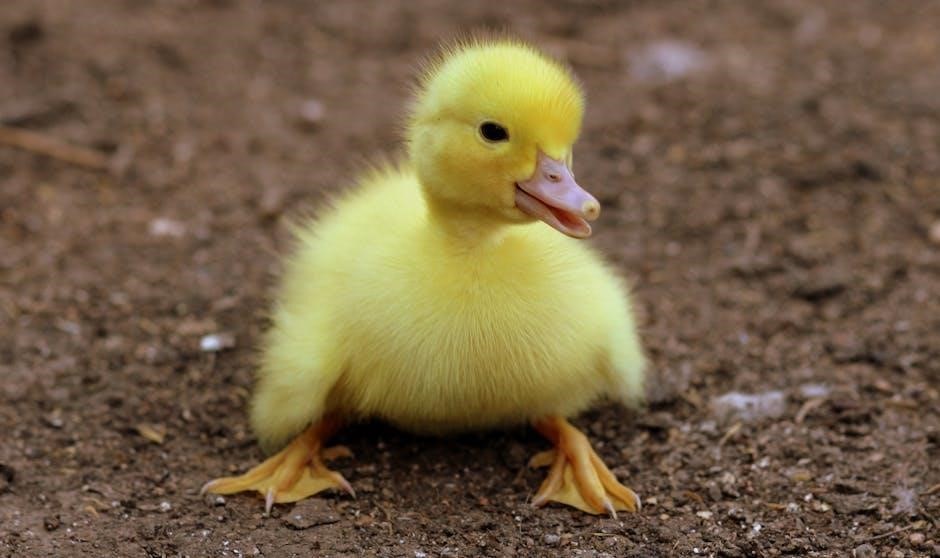Welcome to the Little Giant Incubator Manual! This comprehensive guide provides detailed instructions for setup, operation, and maintenance, ensuring optimal incubation results. Designed to be user-friendly.
Overview of the Little Giant Incubator
The Little Giant Incubator is a popular, user-friendly device designed for poultry enthusiasts and hobbyists. It is a circulated air incubator, ensuring consistent temperature and humidity levels for optimal embryo development. Suitable for various egg types, including chicken, quail, and turkey eggs, it offers versatility for small-scale incubation needs; The incubator is compact, easy to operate, and reliable, making it an excellent choice for those looking to hatch eggs at home. While it is not intended for commercial use, its durability and performance make it a favorite among backyard poultry keepers. It is an ideal tool for anyone seeking to successfully incubate eggs in a controlled environment.
Importance of Proper Incubator Maintenance
Proper maintenance of the Little Giant Incubator is crucial for ensuring optimal performance and successful hatching rates. Regular cleaning and sanitization prevent bacterial growth, which can harm developing embryos. Maintaining consistent temperature and humidity levels is vital, as fluctuations can disrupt the incubation process. Over time, dust and debris can accumulate inside the incubator, affecting air circulation and temperature regulation. Failure to address these issues may lead to poor hatch rates or equipment malfunction. By following the recommended maintenance routine, users can extend the incubator’s lifespan and ensure healthy, consistent results. Proper upkeep also ensures the incubator remains reliable for future use.

Key Features of the Little Giant Incubator
The Little Giant Incubator features an automatic egg turner, circulated air technology for consistent conditions, and versatile capacity accommodating various egg types, ensuring efficient incubation.
Automatic Egg Turner Functionality
The Little Giant Incubator is equipped with an automatic egg turner, a crucial feature that ensures consistent and gentle rotation of eggs during incubation. This mechanism mimics natural incubation by turning eggs at regular intervals, promoting even embryo development and preventing deformities. The automatic egg turner is especially beneficial for hobbyists, as it eliminates the need for manual turning, saving time and reducing the risk of human error. The turner operates quietly and efficiently, ensuring minimal disturbance to the incubation environment. Proper use of this feature requires ensuring it is clean and functioning smoothly before and during incubation. Regular maintenance is recommended to guarantee optimal performance and hatching results. Always refer to the manual for specific instructions on adjusting or troubleshooting the egg turner. This feature is a key advantage of the Little Giant Incubator, making it a reliable choice for successful incubation outcomes.
Circulated Air Incubator Technology
The Little Giant Incubator incorporates advanced circulated air incubator technology, designed to maintain consistent temperature and humidity levels crucial for successful incubation. This system ensures even air distribution, preventing hot spots and promoting uniform embryo development. The circulated air technology enhances heat transfer and maintains a stable environment, which is essential for healthy growth. By circulating air efficiently, the incubator minimizes temperature fluctuations, reducing the need for frequent manual adjustments. This feature is particularly beneficial for hobbyists, as it simplifies the incubation process and increases the likelihood of successful hatching. Regular monitoring and maintenance of the air circulation system are recommended to ensure optimal performance and achieve the best incubation results.
Capacity and Versatility for Different Egg Types
The Little Giant Incubator is designed with versatility in mind, accommodating various egg types and sizes. It can hold approximately 46 chicken eggs, 118 quail eggs, 90 pheasant eggs, or 40 turkey eggs, making it ideal for hobbyists and small-scale poultry enthusiasts. The incubator’s adjustable egg trays ensure proper alignment and support, maximizing space efficiency. This flexibility allows users to incubate multiple species simultaneously, catering to diverse needs. Whether for chickens, quails, or larger poultry, the Little Giant Incubator provides a reliable solution for successful incubation. Its capacity and adaptability make it a practical choice for those looking to hatch a variety of egg types with ease.

Preparation Steps Before Using the Incubator
Before using the Little Giant Incubator, ensure proper unpacking, assembly, and sanitization as per the manual. Check all parts for damage and cleanliness for optimal initial setup.
Unpacking and Initial Setup
When unpacking the Little Giant Incubator, carefully inspect all components, including the incubator base, egg trays, and accessories, to ensure no damage occurred during shipping. Place the incubator on a stable, level surface in a well-ventilated area. Follow the manual’s instructions to assemble the incubator, ensuring all parts are securely connected. Before first use, sanitize the incubator and accessories with a mild detergent solution. Rinse thoroughly and let dry to prevent contamination. Plug in the incubator and allow it to reach the desired temperature before adding eggs. Always refer to the manual for specific assembly and setup instructions to ensure proper functionality.
Sanitization and Hygiene Practices
Sanitization is critical for successful incubation. Before first use, wash the incubator and accessories with a mild detergent solution, ensuring all surfaces are clean and free from contaminants. Rinse thoroughly and allow to dry completely to prevent bacterial growth. Regularly sanitize the incubator during operation by wiping down surfaces with a diluted bleach solution. Always maintain hygiene by washing hands before handling eggs or incubator components. Avoid using harsh chemicals that could damage the unit or harm embryos. Proper sanitization practices will help ensure a healthy environment for embryonic development and prevent contamination risks.

Operating the Little Giant Incubator
Set the incubator to the recommended temperature and humidity levels. Ensure proper ventilation and monitor settings regularly. The automatic egg turner simplifies the incubation process, minimizing manual intervention.
Setting Up the Incubator
Begin by carefully unpacking the Little Giant Incubator and placing it on a stable, level surface. Ensure the area is clean and free from drafts. Plug in the incubator and allow it to reach the desired temperature (typically 99-100°F for poultry eggs). Use the digital controls to set the temperature and humidity levels, referring to the manual for specific guidelines. Fill the water reservoir as instructed to maintain proper humidity. Place the eggs gently in the incubator, ensuring they are clean and dry. Double-check all settings before closing the incubator lid. Allow the unit to stabilize for 24 hours before adding eggs. Always follow the manual for precise setup instructions.
Monitoring Temperature and Humidity Levels
Regularly monitoring temperature and humidity levels is crucial for successful incubation. The Little Giant Incubator is equipped with digital controls for precise adjustments. Set the temperature between 99-100°F and maintain humidity at 50-60% during incubation. Use the built-in sensors to track conditions accurately. Check levels daily, especially during the first few days, to ensure stability. Avoid sudden fluctuations, as they can harm developing embryos. If adjustments are needed, make them gradually. Open the incubator sparingly to prevent drastic changes. Clean and calibrate sensors periodically for optimal performance. Refer to the manual for specific guidance on maintaining ideal conditions throughout the incubation cycle.
Understanding the Egg Turning Process
The Little Giant Incubator features an automatic egg turning system, ensuring eggs are gently rotated at regular intervals. This mimics natural incubation, promoting even embryo development. The automatic egg turner is pre-set to turn eggs every few hours, eliminating the need for manual intervention. For optimal results, stop the egg turning function three days before hatching to allow embryos to position correctly. Manual turning is unnecessary with this feature but can be done if the automatic function is disabled. Always follow the manual’s guidelines for egg turning to ensure healthy hatching rates. Proper egg turning is vital for successful incubation and hatch rates.

Maintenance and Troubleshooting
Regularly clean and inspect the incubator, ensuring proper ventilation. Troubleshoot common issues like temperature fluctuations or egg turner malfunctions promptly. Follow the manual guidelines for optimal performance.
Regular Cleaning and Upkeep
Regular cleaning and upkeep are essential for maintaining the performance and longevity of your Little Giant Incubator. After each use, clean the incubator thoroughly with a mild detergent and warm water to remove any residue or bacteria. Rinse all components carefully and ensure the incubator is completely dry before storing or reusing it. Check for any worn-out parts, such as the egg turning racks or heating elements, and replace them as needed. Proper ventilation and hygiene practices will help prevent contamination and ensure optimal incubation conditions. Always follow the manual’s specific guidelines for cleaning and maintenance to keep your incubator in top working condition.
Common Issues and Solutions
Common issues with the Little Giant Incubator often relate to temperature fluctuations or egg turning malfunctions. If the incubator isn’t holding the set temperature, check the power supply and ensure the unit is placed in a stable environment. For the automatic egg turner, ensure it is properly aligned and free from obstructions. If eggs are not turning, restart the incubator or manually adjust the turner. Humidity issues can arise if water pans are not filled correctly; ensure they are clean and refilled as needed. Always refer to the manual for troubleshooting specific error codes or unexpected behavior.
Final Tips for Optimal Incubation Results
For the best incubation outcomes, maintain consistent temperature and humidity levels, ensuring proper ventilation. Regularly monitor the incubator’s performance and adjust settings as needed. Stop turning eggs three days before hatching to allow embryos to position correctly. Keep the incubator clean and sanitized to prevent contamination. Avoid sudden temperature fluctuations, as they can harm developing embryos. Refer to the manual for specific guidelines on egg capacity and type. By following these tips and adhering to the manual’s instructions, you can achieve successful hatches and healthy hatchlings consistently.
